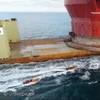Hanjin-chartered Ships Sold, More on Block
Three bulk carriers sold charter-free at about market rates. Two Hanjin container ships also up for sale.
Three ships chartered to Hanjin Shipping Co Ltd have been sold and two more vessels are up for sale, ship brokers said on Wednesday, kicking off an asset sale sparked by the failure of the world's seventh largest container shipper.
Around $14 billion of cargo has been tied up globally as ports, tugboat operators and cargo handling firms worried about not being paid refuse to work for Hanjin, which filed for receivership in a Seoul court on Aug 31.
While some ships have been offloaded since then, bottlenecks are forming at some ports and truck yards as containers pile up.
Three bulk carriers, used for carrying commodities such as iron ore, coal and grain, were sold by lessors for a total of almost $39 million, according to data from ship valuation firm VesselsValue.
The largest, the 180,000 deadweight tonne (DWT) capesize Hanjin Matsuyama, was sold by Japanese shipping firm Kumiai Senpaku to Singapore-based Winning Shipping for $22.75 million, according to the data. An official at Winning said the deal had not yet been completed.
The five-year old ship, last tracked off South Korea, was sold charter-free, meaning it is no longer chartered by Hanjin Shipping, a ship broker told Reuters.
The two smaller 37,000 DWT handyside vessels have been sold to Greek buyers, also charter-free, the broker said.
Vessels that are sold can be bought by their new owners with existing charter, or rental, agreements in place or charter-free, meaning they can be hired out to new firms such as commodities companies.
With prices already depressed by over-capacity, the values achieved were in line with recent similar sales and estimates from shipping services firm Clarkson.
Two container ships worth between $18-$22 million have also been put up for sale, two other ship brokers with knowledge with the matter said.
"Potential buyers have to register their interest by the end of this week with offers by the end of this month," said an Asian secondhand ship broker.
The vessels, both built in 2013, can carry up to 4,522 20-foot containers. The Hanjin Mar is currently anchored off the south coast of South Korea while the Hanjin Marine is heading to Prince Rupert in Canada, according to Thomson Reuters ship tracking data.
A spokeswoman for Hanjin Shipping said the two vessels were chartered and were being returned to the owners, declining to identify them.
Thomson Reuters data and Equasis, a European ship database, showed Panama-registered Tribridge Marine-Oceania and Tribridge Marine-Pacific as the registered owners, but Hanjin Shipping Holdings as the beneficial owner.
Shipbrokers expect more Hanjin ships to be put on the market although uncertainty about the company's future could delay progress and some could be sold off-market to other South Korean companies.
A court has given Hanjin until late November to come up with a rehabilitation plan that creditors agree to.
The fleet of 63 ships Hanjin owns is worth around $1.76 billion, VesselsValue estimates, well short of the $5.5 billion in debt the company reported as at the end of June, 2016. It had chartered a further 78 vessels before its failure.
OVER-CAPACITY TO REMAIN
While uncertainty around Hanjin Shipping has caused a spike in freight prices, few expect it to last.
Cargo ships of around 257.8 million DWT, equal to about 14.6 percent of the global fleet, are due for delivery from now to around 2019 and global seaborne trade growth is just 2.4 percent, Clarkson data shows.
That points to little short-term improvement in the shipping markets with no real return to profitability until 2019-2020, at least, analysts say.
Low scrap values and freight rates higher than operating costs mean there is little incentive for owners to scrap.
"The industry needs to break the trend of halting demolition activity as soon as the Baltic Dry Index (a basket of freight rates) improves marginally," said Peter Sand, chief shipping analyst at shipping lobby group BIMCO.
Around two-thirds of Hanjin's fleet are not operating properly, including vessels seized, barred entry to ports or terminals, denied services or moving slowly, according to Hanjin Shipping data on Monday.
That has delayed grain and oilseed shipment on key global routes, with cargoes carrying pulses from Canada to India running at least 15 days behind schedule.
"We have to queue again and look for other shipping companies which are already witnessing an increased demand for their services," said one Singapore-based trader who ships pulses from Canada.
By Brenda Goh and Keith Wallis













